Tarnished Plant Bug
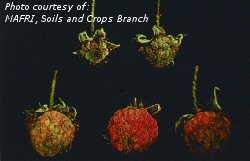
Tarnished plant bug damage to raspberry
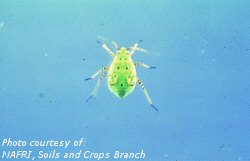
Tarnished plant bug nymph
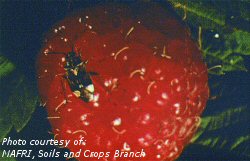
Tarnished plant bug adult
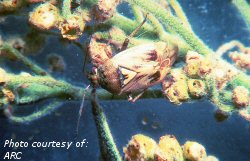
Tarnished plant bug adult
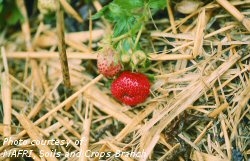
Tarnished plant bug damage to strawberry
Host Plants And Distribution
Plant bugs are widely distributed in North America and have one of the widest host plant ranges of any insect pest. The Tarnished Plant Bug (TPB) feeds on most field, forage, fruit, vegetable and ornamental crops and a wide variety of weeds and many other plants.
Biology
The TPB overwinters as an adult. In early spring, TPBs feed on early emerging weeds and crops, including strawberries. Eggs are laid in plant tissues and when they hatch, the nymphs begin feeding. The nymphs are present and develop through May and June and become adults in late June to early July. These adults repeat the life cycle and both nymphs and adults are found on host plants through the remainder of the summer until fall, when only adults will be present. In the prairies there are two generations per year with a third generation in longer summers. Adults are 5-7 mm in length and 2.5 mm wide. They vary in colour from black to dull brown to pale green. There is a characteristic triangular marking in the middle of the back. The nymphs are pale green in colour, resembling aphids but are much more active. Older instars reach a length of about 5 mm and are darker green with 5 spots on their back.
Symptoms And Damage
Feeding by TPB has two effects. Feeding on flower blossoms and developing fruit causes apical seediness in strawberries and crumbly berry in raspberries. Feeding also reduces plant vigour by removal of plant nutrients. Most damage occurs after petal fall. Damage caused by cool weather during berry formation, poor pollination and some nutrient deficiencies are commonly mistaken for feeding damage by TPB.
Monitoring
Early monitoring of fields is important if damage is to be minimized. It is easily done using a standard, insect sweep net, being sure to sample throughout the field on a regular basis, starting at the bud stage. Growers often sample by tapping the blossom clusters of strawberry plants into shallow trays. This works fine for the nymphs (the most injurious stage). However, the adults fly quickly when disturbed and are often unseen. Because the adults can fly long distances, an outbreak may occur suddenly. Regular sampling and sweeping is needed to detect such infestations.
Scouting Techniques
The most consistent method of scouting is sampling of a number of blossoms across the field. Blossoms are tapped into a white tray or pan and the number of nymphs are recorded. This does not record the number of adults, as they will readily fly away when disturbed. A sweep net may be more useful for sampling adult populations. Particular attention should be given if a nearby hay field has been cut recently. Alfalfa hay is a preferred host for Lygus and once cut, the adults will move out in search of new host plants for feeding and laying eggs.
Economic Thresholds
One nymph or adult Lygus bug in every eight blossoms is the standard threshold that has been developed for strawberries in Canada. This threshold employs the pan sampling method described above. One hundred blossoms should be inspected in each field and an average number of Lygus per blossom determined. If the number exceeds the threshold, then control measures are warranted. Growers may want to delay application if most of the nymphs are young, early instars. This may result in a slight increase in damage but will result in greater numbers of Lygus nymphs being controlled as more will have hatched and be susceptible to control measures.
Comments
Because many weeds serve as alternate hosts, it is important to eradicate weeds in and near strawberry plantings. Because these insects sometimes over-winter in tall grass, any permanent sod should be mowed in late fall. They can be controlled in ornamental plantings by weed control and by keeping lawns or grassy areas mowed to eliminate breeding sites. If alfalfa is grown near strawberry fields, avoid cutting the alfalfa until after the strawberry fruit has been harvested. If cut before this time the insects that are infesting the alfalfa will move directly onto the strawberries.

